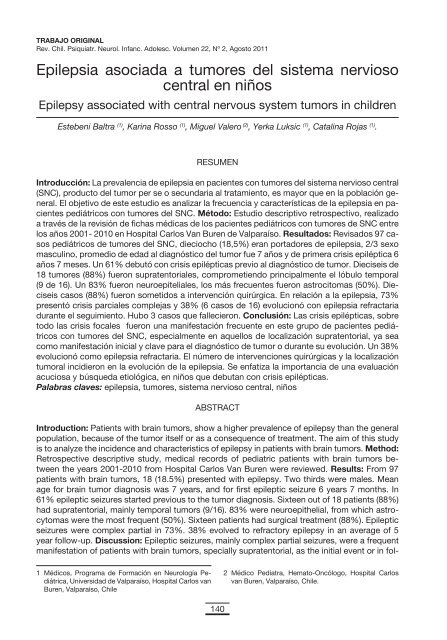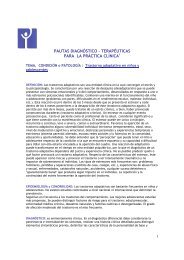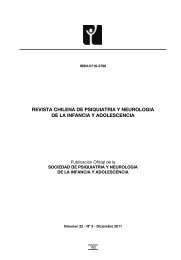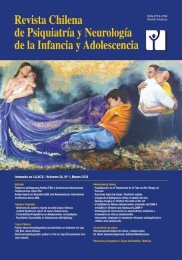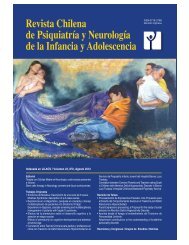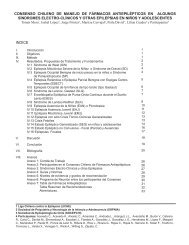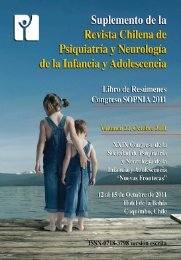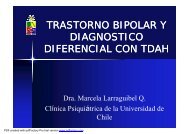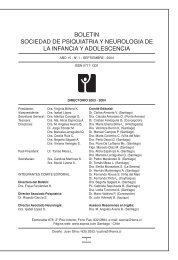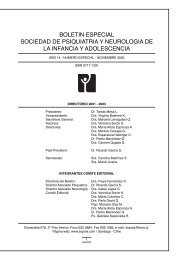TRABAJO ORIGINALRev. Chil. Psiquiatr. Neurol. Infanc. Adolesc. Volumen 22, Nº 2, Agosto 2011Epilepsia asociada a tumores <strong>de</strong>l sistema nerviosocentral en niñosEpilepsy associated with central nervous system tumors in childrenEstebeni Baltra (1) , Karina Rosso (1) , Miguel Valero (2) , Yerka Luksic (1) , Catalina Rojas (1) .RESUMENIntroducción: La prevalencia <strong>de</strong> epilepsia en pacientes con tumores <strong>de</strong>l sistema nervioso central(SNC), producto <strong>de</strong>l tumor per se o secundaria al tratamiento, es mayor que en <strong>la</strong> pob<strong>la</strong>ción general.El objetivo <strong>de</strong> este estudio es analizar <strong>la</strong> frecuencia y características <strong>de</strong> <strong>la</strong> epilepsia en pacientespediátricos con tumores <strong>de</strong>l SNC. Método: Estudio <strong>de</strong>scriptivo retrospectivo, realizadoa través <strong>de</strong> <strong>la</strong> revisión <strong>de</strong> fichas médicas <strong>de</strong> los pacientes pediátricos con tumores <strong>de</strong> SNC entrelos años 2001- 2010 en Hospital Carlos Van Buren <strong>de</strong> Valparaíso. Resultados: Revisados 97 casospediátricos <strong>de</strong> tumores <strong>de</strong>l SNC, dieciocho (18,5%) eran portadores <strong>de</strong> epilepsia, 2/3 sexomasculino, promedio <strong>de</strong> edad al diagnóstico <strong>de</strong>l tumor fue 7 años y <strong>de</strong> primera crisis epiléptica 6años 7 meses. Un 61% <strong>de</strong>butó con crisis epilépticas previo al diagnóstico <strong>de</strong> tumor. Dieciseis <strong>de</strong>18 tumores (88%) fueron supratentoriales, comprometiendo principalmente el lóbulo temporal(9 <strong>de</strong> 16). Un 83% fueron neuroepiteliales, los más frecuentes fueron astrocitomas (50%). Dieciseiscasos (88%) fueron sometidos a intervención quirúrgica. En re<strong>la</strong>ción a <strong>la</strong> epilepsia, 73%presentó crisis parciales complejas y 38% (6 casos <strong>de</strong> 16) evolucionó con epilepsia refractariadurante el seguimiento. Hubo 3 casos que fallecieron. Conclusión: Las crisis epilépticas, sobretodo <strong>la</strong>s crisis focales fueron una manifestación frecuente en este grupo <strong>de</strong> pacientes pediátricoscon tumores <strong>de</strong>l SNC, especialmente en aquellos <strong>de</strong> localización supratentorial, ya seacomo manifestación inicial y c<strong>la</strong>ve para el diagnóstico <strong>de</strong> tumor o durante su evolución. Un 38%evolucionó como epilepsia refractaria. El número <strong>de</strong> intervenciones quirúrgicas y <strong>la</strong> localizacióntumoral incidieron en <strong>la</strong> evolución <strong>de</strong> <strong>la</strong> epilepsia. Se enfatiza <strong>la</strong> importancia <strong>de</strong> una evaluaciónacuciosa y búsqueda etiológica, en niños que <strong>de</strong>butan con crisis epilépticas.Pa<strong>la</strong>bras c<strong>la</strong>ves: epilepsia, tumores, sistema nervioso central, niñosABSTRACTIntroduction: Patients with brain tumors, show a higher prevalence of epilepsy than the generalpopu<strong>la</strong>tion, because of the tumor itself or as a consequence of treatment. The aim of this studyis to analyze the inci<strong>de</strong>nce and characteristics of epilepsy in patients with brain tumors. Method:Retrospective <strong>de</strong>scriptive study, medical records of pediatric patients with brain tumors betweenthe years 2001-2010 from Hospital Carlos Van Buren were reviewed. Results: From 97patients with brain tumors, 18 (18.5%) presented with epilepsy. Two thirds were males. Meanage for brain tumor diagnosis was 7 years, and for first epileptic seizure 6 years 7 months. In61% epileptic seizures started previous to the tumor diagnosis. Sixteen out of 18 patients (88%)had supratentorial, mainly temporal tumors (9/16). 83% were neuroepithelial, from which astrocytomaswere the most frequent (50%). Sixteen patients had surgical treatment (88%). Epilepticseizures were complex partial in 73%. 38% evolved to refractory epilepsy in an average of 5year follow-up. Discussion: Epileptic seizures, mainly complex partial seizures, were a frequentmanifestation of patients with brain tumors, specially supratentorial, as the initial event or in fol-1 Médicos, Programa <strong>de</strong> Formación en Neurología Pediátrica,Universidad <strong>de</strong> Valparaíso, Hospital Carlos vanBuren, Valparaíso, Chile2 Médico Pediatra, Hemato-Oncólogo, Hospital Carlosvan Buren, Valparaíso, Chile.140
Estebeni Baltra et alRev. Chil. Psiquiatr. Neurol. Infanc. Adolesc.Agosto 2011low up. Thirty eight per cent evolved to refractory epilepsy. Number of surgical interventions andlocalization of the tumor affected the evolution of epileptic seizures. The relevance of searchingetiology in children who have a first epileptic seizure is emphazised.Key words: epilepsy, tumors, central nervous system, children.INTRODUCCIÓNLa epilepsia correspon<strong>de</strong> a un grupo <strong>de</strong> trastornosque producen una alteración <strong>de</strong> <strong>la</strong> función<strong>de</strong> <strong>la</strong>s neuronas <strong>de</strong> <strong>la</strong> corteza cerebral,que se manifiesta en un proceso discontinuo<strong>de</strong> eventos clínicos <strong>de</strong>nominados “crisis epilépticas”.Es una afección neurológica crónica,<strong>de</strong> manifestación episódica, <strong>de</strong> diversaetiología (1).En Chile, <strong>la</strong> epilepsia tiene una prevalenciaaproximada <strong>de</strong> 1% en pob<strong>la</strong>ción infantil. Enpacientes con tumores <strong>de</strong>l sistema nerviosocentral (SNC) existe una mayor prevalencia<strong>de</strong> epilepsia que en <strong>la</strong> pob<strong>la</strong>ción general. Aúncuando los tumores <strong>de</strong>l SNC sólo correspon<strong>de</strong>nal 1% <strong>de</strong> los pacientes con epilepsia, <strong>la</strong>scrisis epilépticas son una manifestación comúnen ellos. Se ha observado una prevalencia<strong>de</strong> epilepsia <strong>de</strong> 30-70% en pacientes conneop<strong>la</strong>sias <strong>de</strong>l SNC (2). En niños <strong>la</strong> prevalencia<strong>de</strong>scrita es <strong>de</strong> 15%, aumentando hasta aun 38% en pacientes con tumores supratentoriales(3).Existe re<strong>la</strong>ción entre <strong>la</strong> presencia <strong>de</strong> epilepsiay el tipo histológico <strong>de</strong>l tumor, <strong>la</strong> localización,siendo más frecuente en tumores temporales,mecanismos vascu<strong>la</strong>res y otros mecánicosinvolucrados, tales como liberación <strong>de</strong> neurotransmisoresy el <strong>de</strong>sarrollo <strong>de</strong> cambios morfológicosperitumorales que conlleva cambiosneuronales locales (2, 4, 5). El foco epileptogénicono está en el mismo tumor, sino queprincipalmente en <strong>la</strong> corteza adyacente.El objetivo <strong>de</strong> este trabajo es realizar una <strong>de</strong>scripcióny caracterización <strong>de</strong> los casos <strong>de</strong> epilepsiaen pacientes pediátricos con neop<strong>la</strong>sias<strong>de</strong>l SNC en nuestro hospital.MÉTODOEste estudio se llevó a cabo con una metodología<strong>de</strong>scriptiva retrospectiva. Durante losmeses <strong>de</strong> Mayo a Julio <strong>de</strong>l 2010, se revisaron<strong>la</strong>s fichas <strong>de</strong> pacientes catalogados <strong>de</strong>ntro <strong>de</strong>los diagnósticos <strong>de</strong> <strong>la</strong> décima versión <strong>de</strong> <strong>la</strong>C<strong>la</strong>sificación Internacional <strong>de</strong> Enfermeda<strong>de</strong>s,CIE-10, con los códigos (C69-C72) Neop<strong>la</strong>siasmalignas <strong>de</strong>l sistema nervioso, (D32-D33)Neop<strong>la</strong>sia benigna <strong>de</strong> <strong>la</strong>s meninges, cerebroy otras partes <strong>de</strong>l SNC. Se recolectaron 140fichas <strong>de</strong> pacientes codificados con tumor <strong>de</strong>lSNC entre los años 2001-2010 en el HospitalCarlos Van Buren, todos menores <strong>de</strong> 15 añosal momento <strong>de</strong>l diagnóstico. El análisis estadísticose realizó en StatTA 10.0, se aplicaron<strong>la</strong>s pruebas exacta <strong>de</strong> Fisher y U <strong>de</strong> MannWhitney.RESULTADOSDe <strong>la</strong>s 140 fichas revisadas, 97 eran casos <strong>de</strong>tumor <strong>de</strong>l SNC, el resto correspondían a tumores<strong>de</strong> partes b<strong>la</strong>ndas, meninges u otros. Delos pacientes con tumor <strong>de</strong>l SNC, 18 (18.5%)presentaron epilepsia. 12 <strong>de</strong> los 18 (66,6%)correspondieron al sexo masculino.El promedio <strong>de</strong> edad <strong>de</strong> diagnóstico <strong>de</strong>l tumor<strong>de</strong>l SNC fue a los 7 años. 16 <strong>de</strong> 18 tumores(88%) fueron <strong>de</strong> localización supratentorial(incluido subcortical, se<strong>la</strong>r e intraventricu<strong>la</strong>r),comprometiendo principalmente los lóbulostemporales (9 casos), 16 <strong>de</strong> 18 pacientes fueronsometidos a intervención quirúrgica, <strong>de</strong>los cuales en 7 se realizó una resección total,en los restantes fue una resección predominantementesubtotal. El diagnóstico histopatológicofue <strong>de</strong> astrocitoma en nueve casos(50%), oligo<strong>de</strong>ndroglioma en cuatro casos(22%), un caso <strong>de</strong> pinealob<strong>la</strong>stoma, un caso<strong>de</strong> ependimoma y uno <strong>de</strong> medulob<strong>la</strong>stoma.Siete <strong>de</strong> los pacientes recibieron radioterapiay dos quimioterapia.La edad promedio <strong>de</strong> <strong>de</strong>but <strong>de</strong> <strong>la</strong>s crisis epilépticasfue a los 6 años 7 meses, levementemás precoz que <strong>la</strong> edad <strong>de</strong> diagnóstico <strong>de</strong>l tumor.11 <strong>de</strong> los 18 pacientes (61%), presentó141


